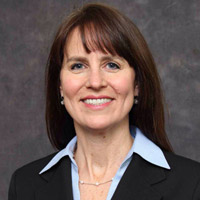New data analytics hold the key to promoting consumerism in healthcare
Today’s improved data analytics have tremendous potential to transform healthcare, and particularly the patient experience, according to industry experts who participated in a panel discussion, “Using data analytics to impact the patient experience of care.” The session concluded the first day of HFMA’s August Digital Annual Conference on Aug. 12.

Anita Samarth, CEO and cofounder of Clinovations Government + Health

Margaret Schuler, system vice president of revenue cycle of OhioHealth in Columbus, Ohio

Tom Swanson, healthcare industry strategist for Adobe Systems, San Jose, Calif.

Chuck Alsdurf, CPA, HFMA director of healthcare financial policy, operational policy
A key theme of the session, sponsored by Change Healthcare, was that data analytics will pave the way for greater consumerism in healthcare.
The three panelists, all leading experts in data analytics, brought diverse industry perspectives:
- Anita Samarth, CEO and cofounder of Clinovations Government + Health, a Washington, D.C., advisory firm
- Margaret Schuler, system vice president of revenue cycle of OhioHealth in Columbus, Ohio
- Tom Swanson, healthcare industry strategist for Adobe Systems, San Jose, Calif.
Impacts of improved analytics
The discussion moderator Chuck Alsdurf, CPA, HFMA director of healthcare financial policy, operational policy, asked the panelists to share where they thought the most impact would be felt in healthcare by improved analytical capabilities.
Samarth noted that access to standardized and structured data is a relatively new development in healthcare.
“The need for that data to be structured is changing because we can do really novel things using technology like machine learning and artificial intelligence to text-based data,” she said. “I would say as a global statement … we can now be actionable with this knowledge and information that we’re deriving from the data. We can tie clinical decisions to drilling down now to not only individual providers, but locations and departments.”
Effective data analytics are of paramount importance in the revenue cycle, in particular, said Schuler. She likened the use of data in the revenue cycle to flying an airplane, where a pilot uses instruments to fly through the fog and successfully land the airplane.
“Data is the same thing to the revenue cycle,” she said.
Schuler emphasized how data can be used across the revenue cycle to give transparency into potential improvement opportunities, including:
- Measuring patient engagement and satisfaction, cash collections and the quality of gathered registration information on the front end.
- Focusing on charge capture and quality of coding in the middle.
- Understand denials and payment variances on the back end.
A consumerism focus
For Swanson, the greatest human impact from the use of data analytics in healthcare is in the area of consumerism.
“For years we talked about patient-centric. Consumerism, in my opinion, is actually a very different thing or evolution of how we engage with patients. It is beginning to treat them like they are informed, proactive consumers of the products and services that we give.”
For patients, Swanson suggested, consumerism means being informed, making good choices, being proactive in the management of their health and wellness, and then voting with their dollars on what the best experience is for themselves as individuals.
Data applications
Schuler offered specific examples of how data can be used to provide deeper insights. She highlighted, for example, the need to identify low-acuity patients who seek care in high-cost locations, such as a person going to the emergency department with a strep throat. Data can help in understand the reason a patient is not getting they care they need from the right place.
“You ask yourself questions [such as] ‘Do they not have a primary care provider?’ ‘Do they not have access to healthcare near them?’” she said. “So it’s very important to link … financial data with the clinical and the quality data to understand what’s happening with that patient.”
Other areas of focus for data analysis Schuler mentioned were:
Understanding causes for readmissions
- Managing length of stay
- Ensuring the right access to care at the right time
- Helping patients with access issues to minimize no-shows
“I can’t stress enough how quality, clinical and financial data all have to come together,” Schuler said. “So from a revenue cycle perspective, I am continuously working with my clinical counterparts … to look at the data from different lenses so we can put action plans and mitigation plans together collectively as a multidisciplinary team rather that in silos.”
Swanson focused on the relationship between these processes and the patient experience: “I think there’s a direct correlation between a good patient experience and a good clinical outcome, and data is the thread that enables you to connect whether the experience that’s being delivered is ultimately resulting in the clinical and financial outcome that you’re looking for.”
Work still to be done
The healthcare industry has made great strides in recent years toward improved use of data.
“We are in a good place for the data that exists between maybe rev cycle and EHR systems in enterprise data warehouses,” Samarth said.
But there is still work to be done, she suggested. “I’m sure there’s other financial and charge capture and inventory management data that isn’t really pulled into these enterprise data warehouses.”
Samarth urged financial leaders to start thinking through what data they lack access to in their enterprise data warehouses and what questions they want to ask that they still cannot answer.
“And even though these systems have the ability to integrate standardized data, the work is incumbent on each provider to do the mapping, she said. “So that’s the dirty little secret.”
Looking to the future
The panel concluded with a discussion of the implications of COVID-19 and the rise in the use of telehealth.
“Telemedicine is a new technology, so now we have another system that is not integrated into the data and structure,” Samarth said.
Swanson elaborated, “Healthcare historically has been a digital laggard in terms of engaging customers, where and how the customers want to be engaged. We were starting to see that change it over the last couple of years, but I think the pandemic has actually been the compelling tipping point that has pushed the healthcare industry into understanding that they need to explore and deliver new models of engagement.”
He concluded, “Once you give consumers the ability to control things more on their terms, I don’t think you can ever go back to . . . the way that it was before, and so my word of advice during this time is, ‘Embrace the change and accelerate it.’”





